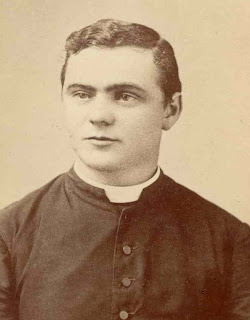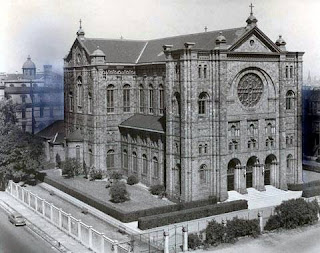During Bishop Loughlin’s episcopate the Diocese of Brooklyn had but two congregations of priests within its limits. The first to come were Lazarists, or priests of the Congregation of the Mission. In the spring of 1868, the Rev. Edward M. Smith, of that congregation, was sent by his superiors to Brooklyn to open a new field for the special work of the community. He was fortunate enough to secure an entire block of ground, bounded by Lewis, Stuyvesant and Willoughby avenues and Hart street. It was bought by Very Rev. Stephen V. Ryan, subsequently Bishop of Buffalo, but who was then Visitor of the Congregation of the Mission in the United States.
There was a little cottage upon this ground and it was soon transformed into a community house. A room was fitted up as a chapel, and here, on July 12, 1868, the first Mass was celebrated, before a congregation of not more than twelve of fifteen persons. On the same day the corner-stone of the temporary church was laid, by Bishop Loughlin. In the following year, 1869, the Bishop laid the corner-stone of the new College of St. John the Baptist, and in September 1870, it was opened under the presidency of the Rev. John T. Landry. Rev. J. Quigley succeeded Father Smith as Pastor of the church in 1868, but Father Smith returned in 1870 and resumed the pastorate, and continued in that capacity until 1874, when he went to LaSalle, Illinois.
On February 9, 1875, Father Landry resigned the presidency of the college and his unexpired term was filled out by the Rev. James A. Maloney. In September following the Rev. P.M. O’Regan became President and Father Maloney became Pastor of the church. Father Maloney was a man of more than ordinary ability and his pastorate was marked by a growth and prosperity that was most gratifying. In September 1877, the Rev. A.J. Meyer became President of the college and he continued in that capacity until 1882, when he was appointed Bishop of Galveston, Texas. Father Meyer’s ambition was to be a good Lazarist and die a good son of St. Vincent de Paul. He pleaded with the Holy See to be excluded from this honor, and among other excuses urged his failing sight. Rome accepted his excuse, and after years of useful service to his congregation as President of St. Vincent’s College at Los Angeles, California, and of Kenrick Seminary, St. Louis, Missouri, he died— as he wished— a good Lazarist.
In 1882 the Rev. Jeremiah A. Hartnett, C.M., became President of St. John’s College and Pastor of the Church. The congregation had outgrown the old frame church and the college had increased in the number of its pupils because it standard had been raised to meet the requirements of the times. A new church was needed, and on June 24, 1888, Bishop Loughlin laid the corner-stone of one of the largest and finest church edifices in the State. It is 208 feet long; nave, including side chapels, 85 feet; width of transept, 135 feet; depth of chancel, 50 feet; and height of ceiling from floor, 95 feet. The material used in the construction of the church is blue granite; the style of architecture is Roman, and the building was under roof before there was a cent of debt on it.
In 1894, The Brooklyn Eagle described the new church building as “perhaps the finest specimen of Roman architecture” in the country.
The new St. John’s was dedicated in May, 1894. The occasion was worthy of the splendid edifice. The dedication was performed by the Rt. Rev. Charles E. McDonnell, D.D., second Bishop of Brooklyn; the solemn Pontifical Mass was celebrated by the Most Rev. William Henry Elder, D.D., Archbishop of Cincinnati, and the dedication sermon was preached by His Eminence, James Cardinal Gibbons, Archbishop of Baltimore. Rt. Rev. Stephen V. Ryan, D.D., Bishop of Buffalo, but who as Visitor of the Congregation of the Mission, had purchased the splendid church property years before, occupied a seat in the sanctuary. It was a happy day for Father Hartnett, and he deserved it.
Source: Peter Ross, A History of Long Island, From its Earliest Settlement to the Present Time (1902), Volume One.
NOTE: For many years the terms “Lazarist” and “Vincentian” were used interchangeably. The former has its roots in the name of the Vincentian motherhouse in Paris, St. Lazare. The church referred to above was originally named St. Mary Queen of the Isles, but was renamed in honor of Bishop Loughlin. The bishop seems to have had a special liking for the Vincentians (even before they renamed the church), although he was not generally fond of religious orders. He felt that they tended to “steal vocations” that might have otherwise gone to Brooklyn. In an 1889 Brooklyn Eagle article about the bishop, it was said the he particularly disliked “two classes of persons,” reporters and Jesuits. The difference, it was noted, was that he talked to reporters every now and then.
















